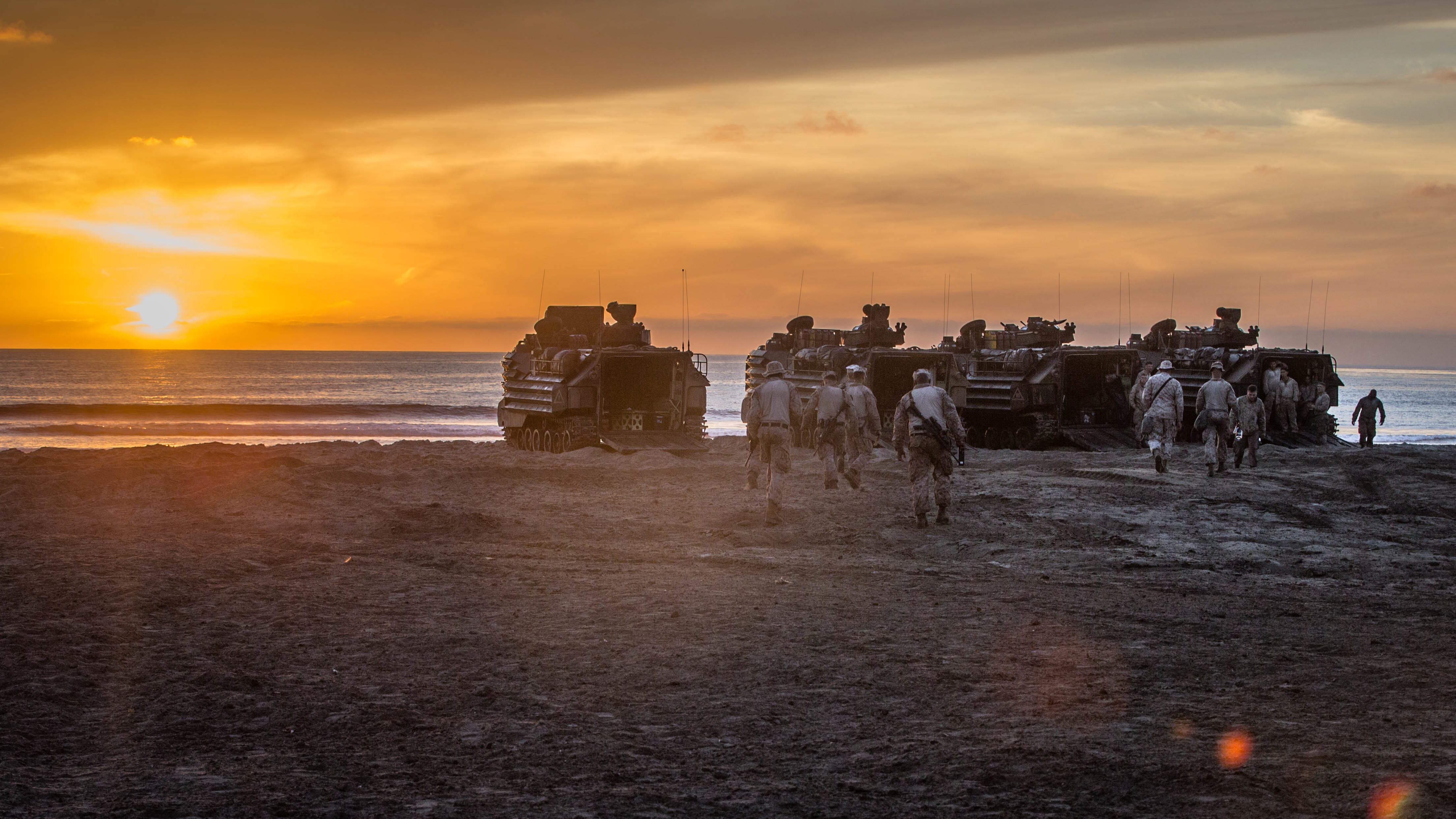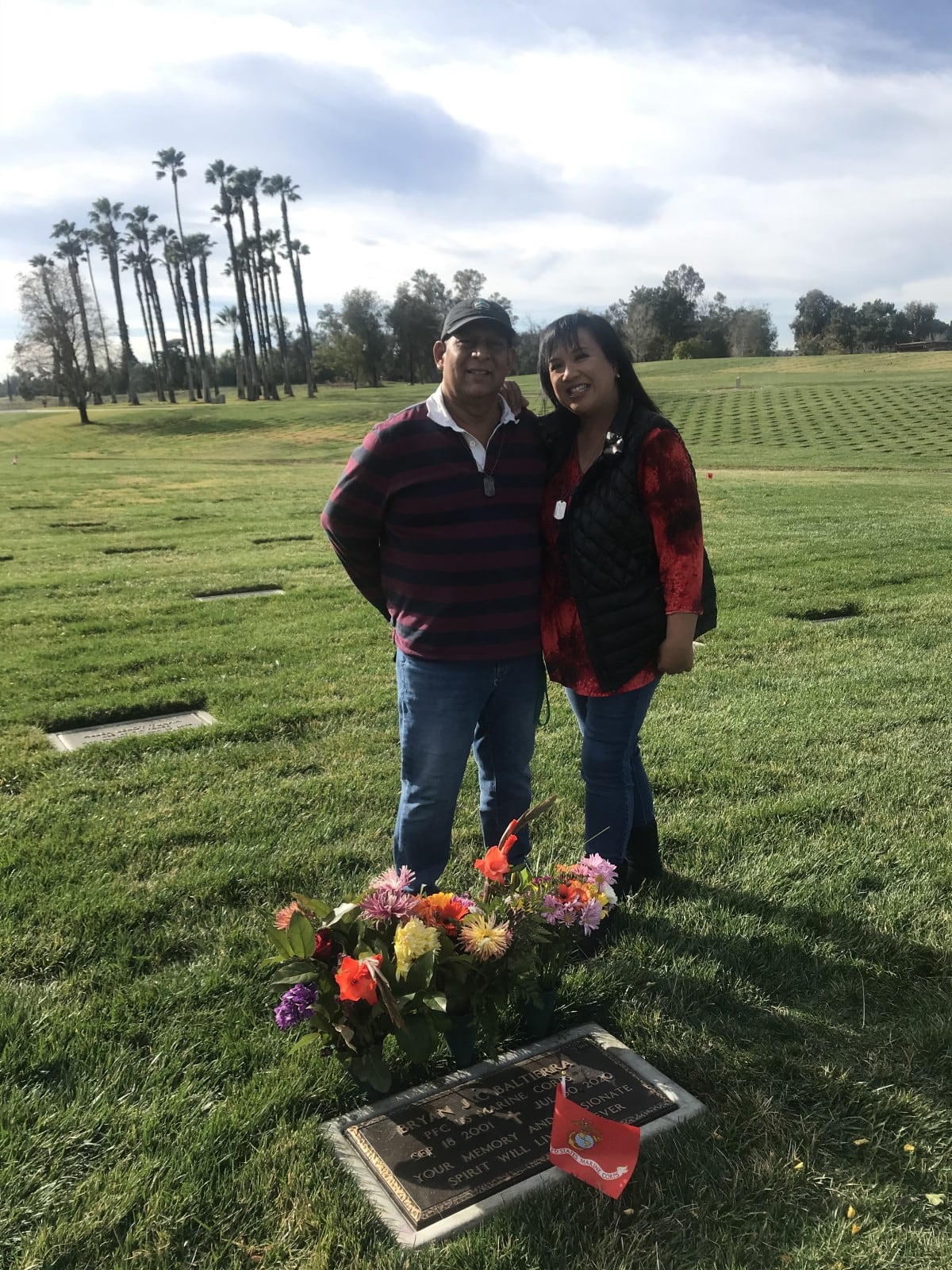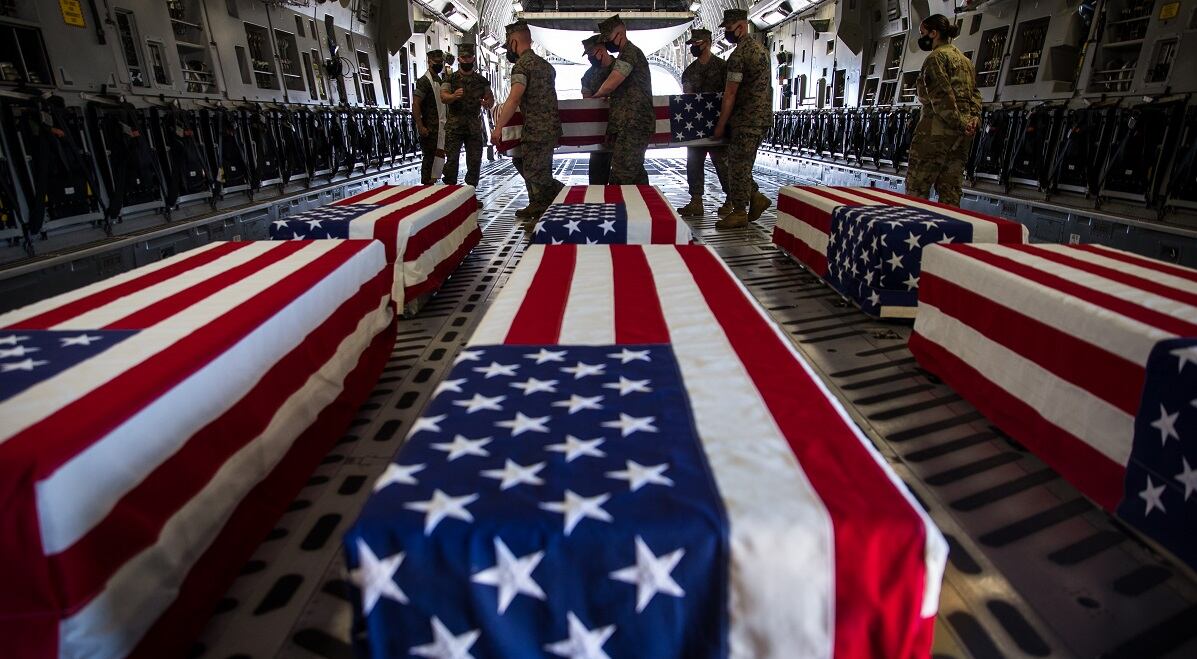When a Marine Corps amphibious assault vehicle with 15 Marines and one sailor aboard started sinking off the coast of California on July 30, 2020, no safety boat was in sight.
As the water inside the AAV rose to calf level the vehicle commander went to the top and started waiving the “November” flag ― a blue and white checkered flag indicating a possible sinking, because the ship’s radio communications were down.
The Marine stood waving the November flag for 20 minutes before any neighboring vehicles noticed. As the vehicle was going down, one of the AAV crewman told the infantry Marines in the back to open the rear hatch so they could escape, a slide into the report obtained by Marine Corps Times said.
When the cargo hatch would not open the crewman attempted to open the hatch himself before discovering that the “handle had spun past the open position due to a broken woodruff key,” which delayed evacuation.
Eventually two AAVs moved to help the sinking vehicle. But that quickly made the situation, which was becoming dire, worse.
One of the rescue vehicles hit the sinking vehicle, pushing it broadside into the waves. After one large wave hit, water rushed into the sinking vehicle ― sending it rapidly to the floor of the ocean.
At this point eleven service members were still inside, sinking with their ship in darkness, as the emergency egress lighting had failed. The other five Marines had safely evacuated from the vehicle before it completely sank.
On that fateful summer evening, Lance Cpl. Chase Sweetwood, 18, was trapped inside, praying with Pfc. Bryan J. Baltierra, also 18, a fellow platoonmate from boot camp, a Marine who survived the AAV accident later told Baltierra’s mother, Evelyn.
“Evan and Bryan were praying together, because ... that’s all they had in the darkness,” Evelyn Baltierra told Marine Corps Times. “They were praying together because they knew they couldn’t make it.”
Anger, disgust and unimaginable grief were some of the words used to describe the emotions felt by some the families of the nine service members who didn’t survive that day.
The families have just been briefed on the accident investigation ― eight months later finally giving them some more answers into the tragic deaths of their beloved sons, brothers, nephews, grandsons. The investigation was publicly released late Friday after all the families of the deceased service members had been briefed on its findings by the Marine Corps.
RELATED

An investigation into the accident showed the sinking was caused by a series of errors starting at the top of the 1st Marine Division, which sent Marines to the 15th Marine Expeditionary Unit, all the way down to the AAV crew, which failed to evacuate the Marines when the water started to rapidly rise inside the vehicle.
All but one of the 11 service members who went down with the AAV were able to escape the vehicle before it hit the ocean floor. But most of those service members never reached the water’s surface.
They all were wearing heavy small arms protective inserts plate carriers. Seven still had Kevlar helmets on and two still had their rifles on their body, weighing them down and preventing any chance they had to get to the surface.
Three Marines did make it to the surface, but Lance Cpl. Guillermo S. Perez, a 19-year-old rifleman from New Braunfels, Texas, still did not make it. Marines performed an hour of continual CPR on Perez after they recovered him, but he eventually was pronounced dead on the scene.
The other Marines who died that day were Pfc. Bryan J. Baltierra, 18, of Corona, California, a rifleman. Lance Cpl. Marco A. Barranco, 21, of Montebello, California, a rifleman. Pfc. Evan A. Bath, 19, of Oak Creek, Wisconsin, a rifleman. U.S. Navy Hospitalman Christopher Gnem, 22, of Stockton, California, a hospital corpsman. Pfc. Jack Ryan Ostrovsky, 20, of Bend, Oregon, a rifleman. Cpl. Wesley A. Rodd, 22, of Harris, Texas, a rifleman. Lance Cpl. Chase D. Sweetwood, 18, of Portland, Oregon, a rifleman. Cpl. Cesar A. Villanueva, 21, of Riverside, California, a rifleman.
“They were murdered, there is no other way to put it,” Paul Woerner, Lance Cpl. Chase Sweetwood’s stepfather, who raised the Marine since he was a little boy, told Marine Corps Times. “They were failed from the minute these were chopped into service to the minute it sank.”
‘Human and mechanical failures’
So far at least two Marines have been fired from their command because of mistakes they made that led to the nine deaths, with more disciplinary action still being considered for several Marines, according to the investigation.
Col. Christopher J. Bronzi was fired from his position as commander of the 15th Marine Expeditionary Unit in March for “a loss of trust and confidence in his ability to command, following completion of the command investigation.” In October 2020 the Marine Corps fired Lt. Col. Michael Regner, the commander of Battalion Landing Team 1/4 with the 15th MEU, as a result of the accident.
“The investigation reveals a confluence of human and mechanical failures caused the sinking … and contributed to a delayed rescue effort,” Lt. Gen. Steven Rudder, commander of Marine Forces Pacific, said in the investigation.
All eight Marines and one sailor were assigned to Bravo Company, Battalion Landing Team 1/4 for the upcoming deployment on the 15th MEU, while the AAV crew, who all survived, were assigned to the MEU’s AAV platoon after being detached from 3rd Amphibian Assault Battalion.
Lance Cpl. Chase Sweetwood enlisted in the Marine Corps at age 17, eager to serve his country and continue to find adventure in his life
“He always wanted to, so badly, be Marine … from the time he was real little,” said Christiana Sweetwood, Chase Sweetwood’s mother.
Christiana Sweetwood said she feels some personal guilt for allowing her son to enlist at 17, but that she never thought the Marine Corps would fail her son so disastrously.
Beyond the failures that led to the sinking of the AAV, Chase Sweetwood should have been in medical and shouldn’t have been at work due to a severe foot injury, Christiana Sweetwood said, but he was too afraid of his chain of command to say anything about the injury.
RELATED

“You look clear from the beginning and it was bad from every single person down, they failed, they failed, they failed, they failed going down that line,” Christiana Sweetwood said, comparing the buildup of mistakes to premeditated murder.
“You clear from the beginning had red flag, red flag, red flag. Then they died.”
For Carlos Baltierra, Evelyn Baltierra’s husband and Pfc. Bryan J. Baltierra’s father, the investigation was not enough.
He sent back a series of questions to the Marine Corps and hopes to learn more about the history of the specific AAV they had been in.
In the investigation, the Marine Corps found the AAV had spent nearly a year on the deadline lot before being assigned to the 15th MEU.
After Marines in the AAV platoon told leadership of the 3rd Assault Amphibian Battalion the vehicles they were designated were not capable of deploying, the battalion sent them three more mechanics and told them to make it happen, according to the investigation.
“It actually starts with the chain of command,” Carlos Baltierra told Marine Corps Times.
But questioning is not where he plans on stopping.
“I’m looking at the US military, the Marines, the Navy, and also the manufacturer of the AAVs,” he said. “The AAV, that really basically exposed everything inadequate.”

On board the AAV with Lance Cpl. Chase Sweetwood and Pfc. Bryan J. Baltierra as the vehicle sank was Navy Hospitalman Christopher Gnem, 22, the only non-Marine to die in the incident.
Gnem was a beloved son who spent high school inspiring kids on his basketball team and protecting an autistic boy on the football team from bullying, his mother, Nancy Vienna, told Marine Corps Times.
“The day he went I died with him,” Nancy Vienna said.
“I haven’t been sleeping or eating. Because of this, and they come and just say ‘sorry,’” she said.
Gnem’s stepfather, Peter Vienna, also pointed to what he says is a failed culture of the Marine Corps that puts mission before people, even if it is just a training mission.
“If I hear one more time, ‘We have to train how we fight,’ I’m going to throw up,” Peter Vienna said.
The Marines and sailors were killed because the Marine Corps ranked the importance of that training mission higher than the safety of his son, Peter Vienna said.
Marine Corps Times has asked the Marine Corps to comment on this assertion and others, but has not yet heard back other than being pointed to the accident investigation.
“They murdered my son,” Nancy Vienna told Marine Corps Times. “They put him on a railroad track, tied him up and said, ‘Hey the trains coming just stand there, die. Wait you’re getting murdered today. … It’s your date of death; I just need to finish this mission.’”
‘I have lost my whole world’
On the morning of the incident a small boat from the Navy originally intended to act as the mission’s safety boat had mechanical problems and was unable to be put into the water, according to the investigation. In its place two AAVs were assigned as the safety vehicle. The two AAV substitute was within Marine Corps regulations.
For the return trip there had been a Navy safety boat available, the investigation later showed, but no one had thought to request it. A safety boat however might have made a difference in timing and better maneuvering around the sinking AAV.
But it was more than just the safety boat that was having issues that day. Mechanical problems continued to plague the mission as several AAVs broke down along the way.
At no point did anyone consider halting the mission or taking a closer look at the mechanical issues plaguing the AAV platoon, according to the investigation.
“They’re lucky that only one AAV sank,” Peter Vienna said. “Those boats were not seaworthy; they were junk and they shouldn’t even have been put in the water.”
Though the AAV had several leaks that should have deadlined the vehicle and kept it from going out that day, the main failure was the transmission.
The vehicle had a massive oil leak while on the beach of San Clemente Island, but after the rear crewman tightened up a few bolts and poured six gallons of oil into the engine, roughly a quarter of what is needed to operate the transmission, the decision was made by the vehicle commander, who survived the accident, to make the trip back across the water to the Somerset.
The transmission failure sent the engine into an idle, according to the investigation. The idle caused the vehicle to stop in the water, and the loss of forward momentum prevented the forward hydraulic bilge pumps from pumping out water.
The rising water level in the engine led to water hitting the generator, causing the generator to fail, eventually leaving the remaining bilge pumps operating at a degraded level, the investigation found.
Lance Cpl. Marco A. Barranco, 21, was Lupita Garcia’s youngest child and only son. Though mischievous as a young boy, he grew up to have a “huge heart,” Lupita Garcia said.
Growing up he forced his older sisters to play soldier with him, she said. But it was when his father give him Marine Corps dog tags at age 10 that his path to the Marine Corps was set.
Lupita Garcia likened the AAV to an old, broken-down car.
“It’s like me saying, ‘Drive my 40-year-old car,’ not knowing the transmission is working correctly,” she told Marine Corps Times. “‘Here drive it 60 miles per hour.’ How could I do that?”
“How long have you been a Marines that you can’t make better decisions?” Garcia said, “Obviously I am so angry at so many failures, so many humans failures … I feel sick.”
Beyond the mechanical failures of the AAV and the lack of safety boats, the evacuation was hindered by the utter lack of training the Marines embarked on the AAV had before being sent on the mission.
The AAV crew was hastily put together before the MEU was underway and the rear crewman was a last-minute addition after the normal rear crewman tested positive for COVID-19, the investigation found.
COVID-19 also was blamed for the lack of dunk tank and life preserver training the Marines from BLT 1/4 had.
Only two of the 13 Marines embarked on the mission had fully completed required underwater egress training, the investigation found.
Two of the service members were not even swim qualified.
“Our son they told us, they couldn’t even find that he ever got swim qualified,” Peter Vienna said.
For Aleta Bath, mother of 19-year-old Evan Bath, the what she calls sheer incompetence by the Marine Corps has shocked her.
“At the end of the day, through a lack of following standard operating procedures, lack of training, extremely bad decision-making and lack of accountability, I have lost my whole world,” she said.
“I’m extremely angry, so angry I don’t really know how to react right now. I’m also in shock at the sheer number of factors that contributed to the accident.”
Evan Bath was a “brilliant,” “wonderful” and “funny” boy, who grew up a bit shy but blossomed into an extrovert when he became a Marine, Aleta Bath said.
“From what I’m hearing it was raining, bad conditions, and they were stuck in a foxhole training and he was the one cracking jokes,” she said.
More Marine Corps mistakes
For two of the families, the Marine Corps’ mistakes did not stop at the sinking of the AAV.
The Marine Corps repeatedly misfiled or delayed the process of paperwork, Christiana Sweetwood and Aleta Bath told Marine Corps Times.
Though her casualty assistance officer has been “wonderful,” dealing with the bureaucracy of the Marine Corps has been hard for Aleta Bath.
“They made mistakes on my son’s paperwork. ... They had to amend the death certificates,” Aleta Bath said.
“This is your biggest accident in the history of the Marine Corps and you can’t even get the date right,” Aleta Bath said.
When Marine Corps Times asked for comment on this, official spokesmen referred Marine Corps Times back to the investigation.
The accident was the single deadliest AAV accident in Marine Corps history.
“We haven’t been kept abreast of what’s been going on,” Aleta Bath said.
Many of the families said they have been left in the dark by the Marine Corps for several months as they did their own research into what happened.
“They kind of just disappeared for us, we had our CACOs (casualty assistance calls officers) but we weren’t receiving 30 days update since November or December,” Christiana Sweetwood said.
“So for seven, eight months we had to do our own research, they left us with nothing,” she added.
The Marine Corps has not yet responded to Marine Corps Times about this specific allegation.
As the shock of the investigation news wanes, the families are contemplating next steps.
They are hemmed in from filing a lawsuit against the Marine Corps for the wrongful deaths of their sons by the Feres Doctrine, which courts repeatedly have used to block lawsuits against the government for wrongful death or medical malpractice.
“I think that is part of the systemic problem in the military the overreaching power of the Feres Doctrine that keeps them from being accountable,” Peter Vienna said. “It’s very unfortunate but sometimes money speaks louder than lives.”
Some still want more answers.
“There’s a number of questions that are outstanding,” Carlos Baltierra said.
The families are still waiting on a second investigation from the Naval Safety Center, one that officials said will not be released publicly.
For almost all the families, the plan for now is to work with Congress to revoke the Feres Doctrine, and hold all the people whose decisions led to the sinking of the AAV accountable for their mistakes.
Members of the House Armed Services Committee will be meeting with the Marine Corps the last week of March/first week of April for their own briefing, Marine Corps Times previously reported.
But though they still have hopes for justice, nothing will ever replace the precious lives taken from them by a series of what they say are inexcusable mistakes from Marine Corps leaders.
“The Marine Corps slogan is we take the best of the best, the few the proud the Marines,” Christiana Sweetwood said.
“But if they were the best why are we not giving them the best?” she asked, referencing the equipment the Marines were given. “We failed them, we failed them as a country, we all failed them.”
The damage to the bodies led to most of the families to opt for closed casket funerals and a foregoing of any final physical goodbye ― a decision Nancy Vienna regrets to this day.
“I’m Buddhist, that’s our last goodbye sending him off with spirits and good thoughts they didn’t even give me that chance,” Nancy Vienna told Marine Corps Times.
“I don’t have closure.”





